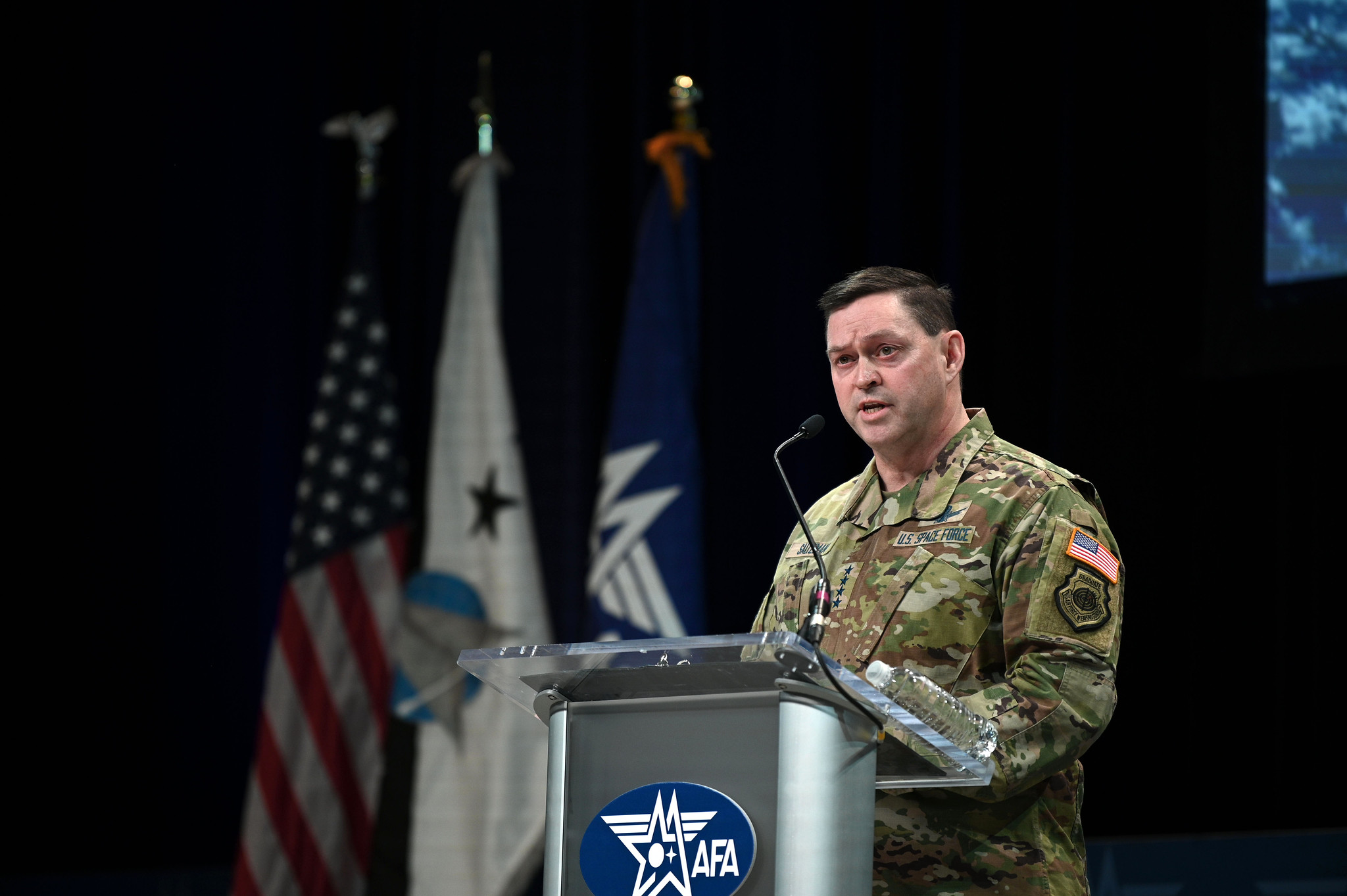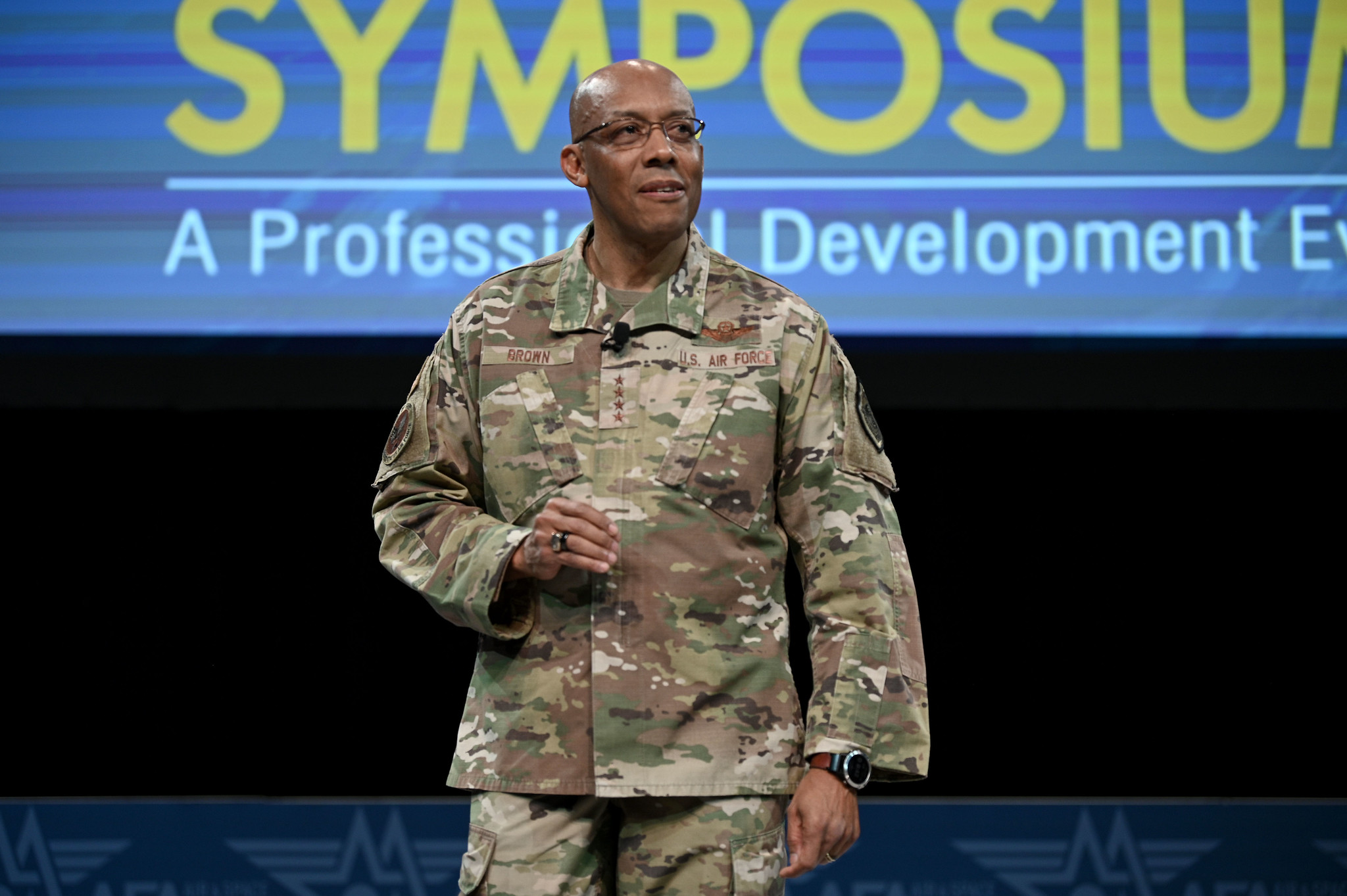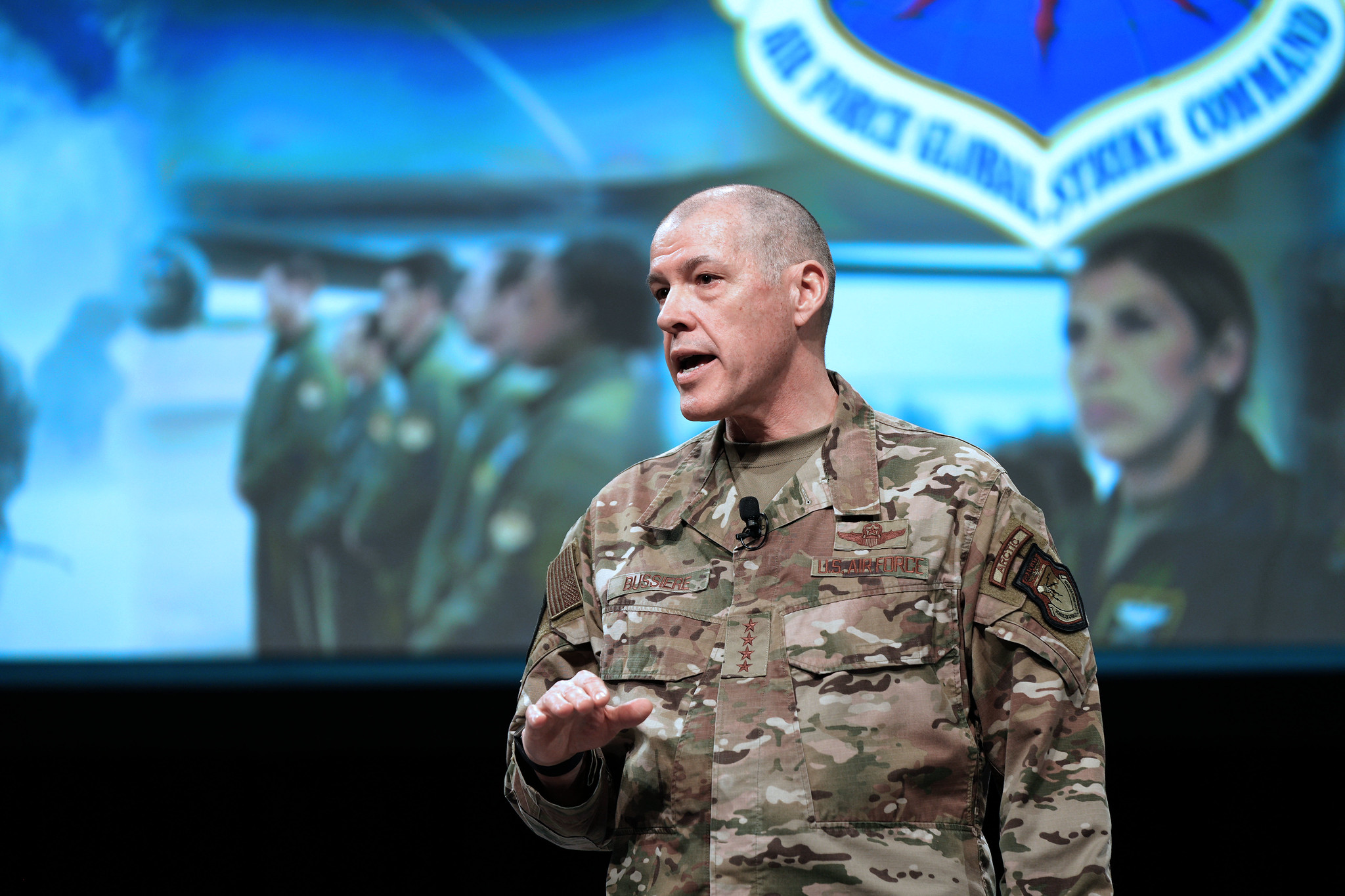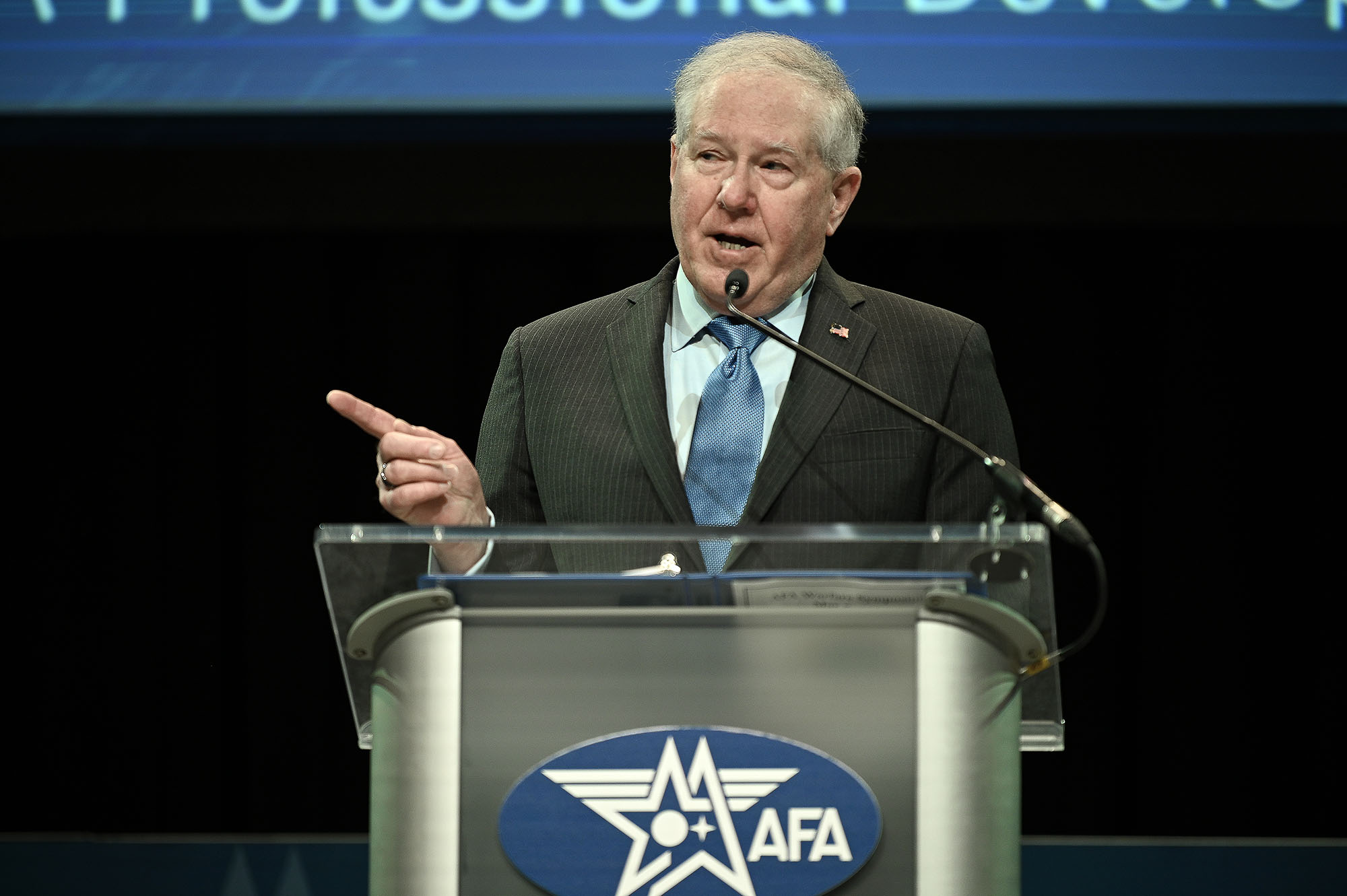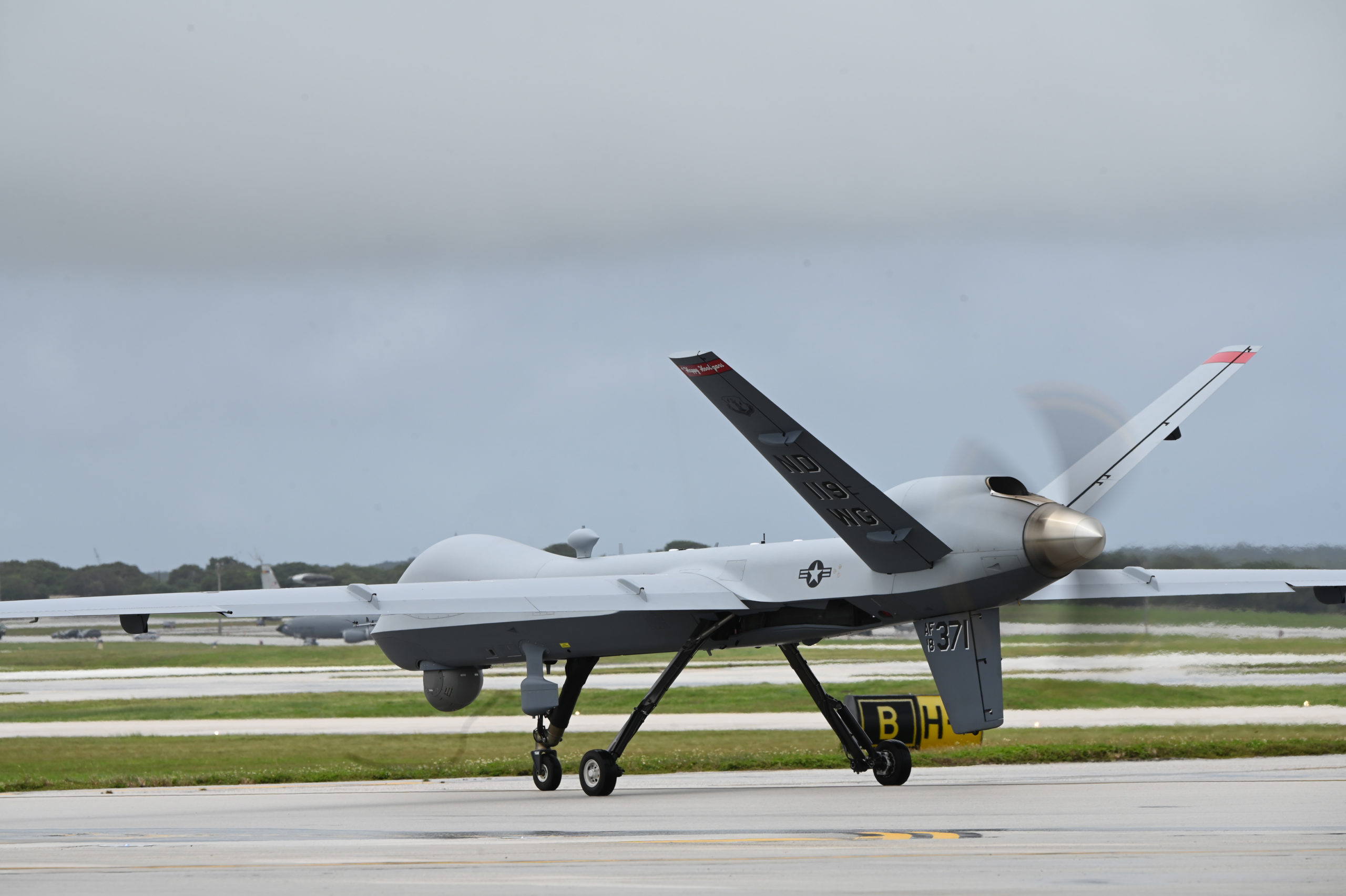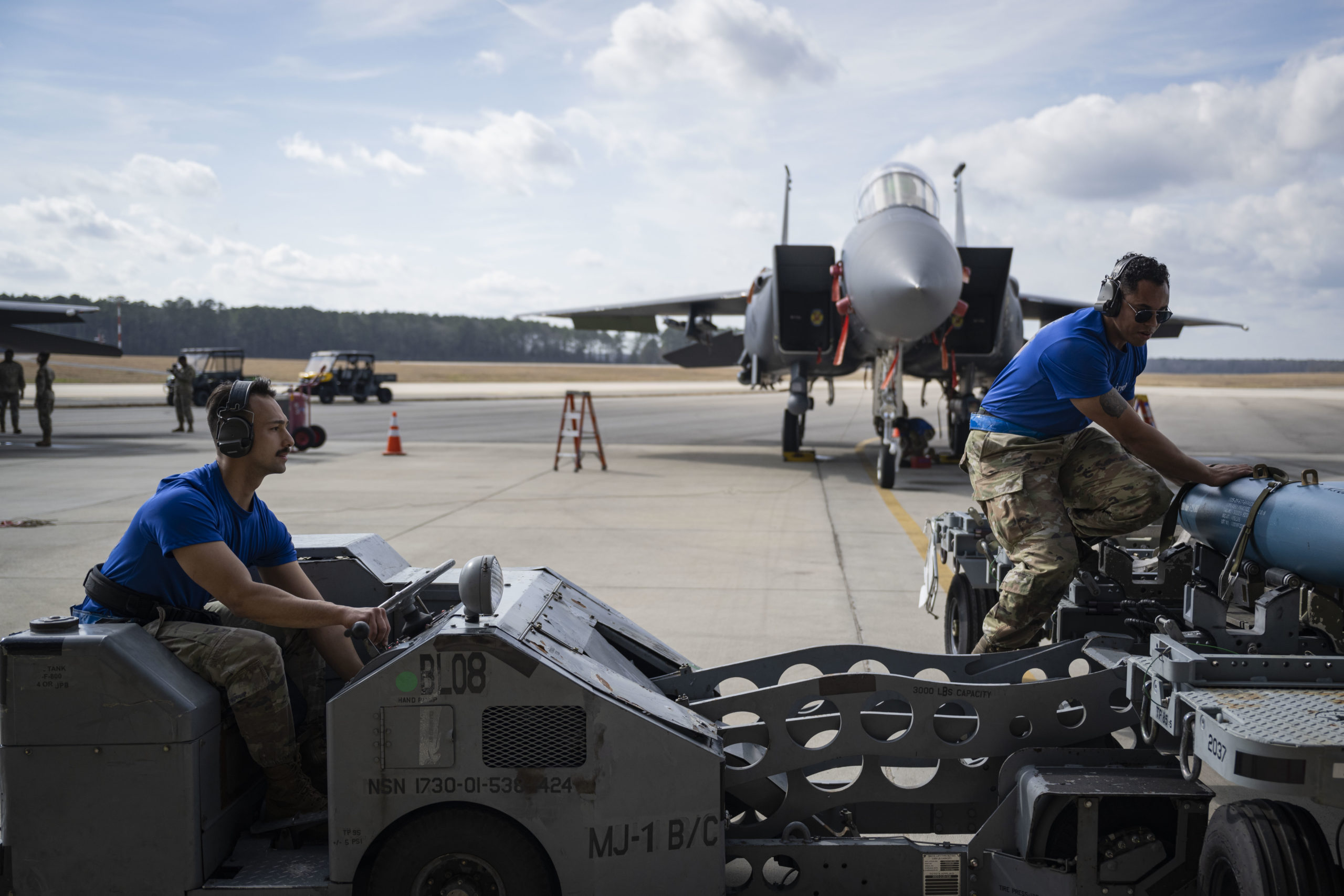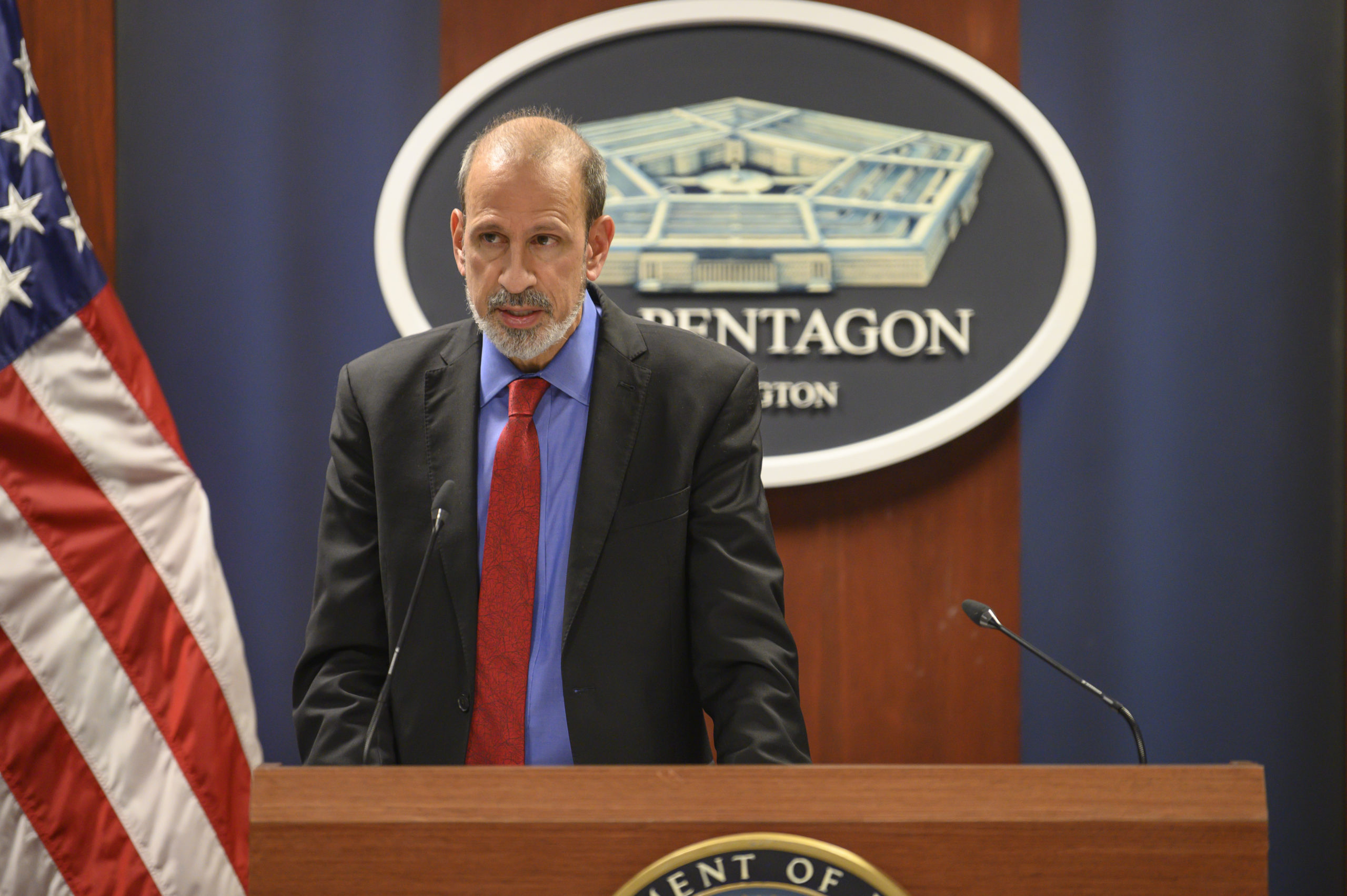Chief of Space Operations Gen. B. Chance Saltzman delivered a keynote address on “Guardians in the Fight,” laying out his theory of success for the Space Force called “Competitive Endurance” at the AFA Warfare Symposium, March 7, 2023. Watch the video or read the transcript below.
Voiceover:
Ladies and gentlemen, welcome back. Please join me in welcoming the President & CEO of your Air & Space Forces Association, Lieutenant General Bruce “Orville” Wright.
Lt. Gen. Bruce “Orville” Wright (Ret.):
Well, this is pretty awesome, I think you would agree. It’s only 10 o’clock in the morning and the Chinese are even more defensive, so God bless you guys. So last spring, our association, your longstanding 76-year-old AFA got a new name, the Air and Space Forces Association. And Space is now our middle name.
The delta is half of our logo. Guardians are in the same fight as our Airmen. We are one team and one fight at the leading edge of the kill web. And just as I had the privilege of introducing Chief Brown to speak on the importance of our Airmen, it is now a humbling privilege to introduce the Chief of Space Operations to speak about our Guardians and their families.
General Chance ‘Salty’ Saltzman is the second CSO in Space Force history. He launched in November, and though it has only been a few short months, Salty is at orbital velocity in shaping strategic objectives for a nation’s younger force. And let me underline, he is a war fighter. And so it is with great honor that I present to you your Chief of Space Operations, General ‘Salty’ Saltzman.
Chief of Space Operations Gen. B. Chance Saltzman:
Thank you. Wow. Bright lights, lots of people. This is exciting. It’s a real honor to be here. What an amazing crowd. What an amazing venue. Thanks to Orville, Bernie, Doug, all the AFA team, volunteers, members for this opportunity to speak about the Space Force. Secretary Kendall, thanks for your vision, your leadership, and for setting the right tone for us to get after these critical missions against our threat.
CQ Brown, thanks for being a great wingman. Thanks for showing me what being a leader and a service chief looks like. Wow. How about those senior leader keynotes? Pretty amazing, huh? Pretty. Let’s give it up. Those were … Watching those senior keynote speeches being delivered got me thinking about Ricky Bobby. If you ain’t first, you’re last. Very impressive.
So what about this? Next year we’ll have another Jeopardy clip. The answer will be Salty Saltzman. The question will be, who doesn’t want to follow CQ Brown presentation? That’s only halfway a joke. I’m telling you. Now it’s my turn to take you back in history a little bit.
In July of 1997, I was an Air Force intern in the Pentagon assigned to the Air Staff history office. It was an exciting time to be in the office because as of September that year, we were marking the 50th anniversary of the US Air Force. So there was quite a bit of demand for history in the form of research for senior leader speeches, development of handouts for air shows and other events.
And I was blessed at the time to be working under Dr. Dan Mortenson, who had been with the Air Staff history office longer than anyone could recollect. He was an amazing historian, storyteller and very generous with his time. Now, at that time, I’d only been in the Air Force for about five years, mostly performing ICBM operations.
I joined the Air Force through ROTC as a way to pay for college, and I didn’t really come from a family with extensive military background. All that is to say I really didn’t know that much about the Air Force and much less about its history. Dr. Dan set out to fix this. Day after day he would tell stories to me about historic leaders, aircraft, missions of the Air Force, seemed like he knew everything.
In fact, his detail left me to believe that in many instances he may have actually been there and heard the accounts firsthand from witnesses. Almost every night he would pull a book from our shelves and tell me to read it, or at least a chapter that captured the key insights and details. And I remember him telling me that to understand how the Air Force works, you have to understand the early days, the formative years of flight.
You had to understand what the original men and women went through before they were the senior officers making the key decisions. He told me stories, made me read about Ira Aker, Pete Cassada, Loris Norstad, names I’d never heard before. He told me about the Pan-American flights, the question mark flight, Operation BOLO, missions I’d never heard of.
He made me read “Global Mission,” Hap Arnold’s autobiographical account of the development of airpower. I remember this in particular because he gave the book on a Friday and said he wanted to talk about it on Monday. So I spent a weekend slogging through Hap’s 386 pages of questionable prose with mind-numbing details on the early days of aviation.
On Monday, Dr. Dan asked me what I thought, and as I paused to organize my thoughts, he said, “Hard to read, huh?” He said,” Hap was a better pilot than a writer,” and I agreed, but as we talked about it, the storyline became clear. The early days of military aviation, 1920s and ’30s was a time of experimentation searching. The pilots were experimenting with new technology and its military applications, but more importantly, they were searching for a theory of success.
How should airpower be used? What unique contribution could it make to fighting and winning wars? What was different about these weapons and the domain of the air that required dedicated training, education, expertise? Now the circumstances and timelines of spacepower development are not exactly the same as airpower.
I personally have been integrating space capabilities into the joint fight for well over 20 years, and the U.S. has been leveraging space capabilities for many decades more. However, the emergence of space as a contested domain of war itself is a relatively new phenomenon. The experimentation and search for military applications from a contested domain is a much younger proposition and more clearly connect to the air power efforts of the ’20s and ’30s.
When I listen to CQ Brown talk about air power, I hear an Airman that has not only benefited from his 30 plus years of training, education, experiences, but I hear the results of a service that for 75 years in counting, has determined what air powers does and how it does it, the value it brings to the force. It is through this lens and as an evolution of those lessons that I believe the U.S. Space Force must propose, evaluate, and evolve its own theory of success for contesting the space domain and ensure the U.S. can continue to enjoy the advantages we have secured from superiority on the ultimate high ground.
So in memory of Dr. Dan, a great mentor and friend to whom I am forever grateful, I would like to describe a theory of success for the Space Force. This theory is not an answer to the question, but rather a proposal, a point of departure to start the debate and discussions regarding how the Space f\Force accomplishes its primary mission and best contributes to the joint team.
Now before the theory, I think it’s important to set the scene by describing the evolution of the space domain. For over 50 years, the U.S. has built the world’s most capable force enhancing globally integrated space capabilities on the planet with unrivaled abilities to access and exploit the space domain. And this includes world-class satellite communications, missile warning sensors, position, navigation, and timing, and other capabilities that have assured the U.S. military is the envy of the world and the finest combat force in history.
We were so successful in fact that our competitors watched, they plotted and they invested in capabilities to blunt our advantages in space. The rise of these threats against on orbit systems and increasingly threats to the joint force itself from adversary satellites drove us to the realization that we must be able to contest and when necessary control the space domain.
Why? Because these threats are not just academic discussions any longer. From the Chinese anti-satellite system test in 2007 to the Russian test in November of 2021, these irresponsible weapons tests provide a worrisome glimpse of what conflict in the space domain may entail with the potential for unrestrained military force, creating catastrophic levels of debris that could render wide swaths of valuable orbits useless, limiting access to space capabilities that provide prosperity and security for the United States and the world.
We’ve seen a payload launched into orbit, fly around the world, and then re-enter the atmosphere gliding and maneuvering at hypersonic speeds to its target. We’ve seen a demonstration of a satellite grabbed by another satellite’s robotic arm and pulled out of its mission orbit, and it doesn’t stop at tests. We’ve seen cyber attacks knocking out thousands of space-based internet terminals, widespread attempts at satellite communications, and GPS jamming.
The rise of these threats creates the primary mission of the U.S. Space Force to protect our capabilities and defend the joint force from space enabled attack. The United States established the Space Force to protect our nation’s interest in space. Our formative purpose as Guardians is to protect and to protect, we must be able to contest and control the space domain or in military terms, to achieve space superiority.
Contesting and controlling a domain is a complex endeavor, which is why the Department of Defense relies on its military services to dedicate themselves to the purpose. In the same way we need the Air Force to gain and maintain air superiority, the joint force needs its space force dedicated to gaining and maintaining space superiority.
A military service dedicated to a domain gives our joint force the tools, the depth and institutional experience specialized for domain control. In space, this is a critical prerequisite to follow on space operations needed for joint force effectiveness. The service does this by bringing the full weight of its resources and authorities to focus on meeting the challenges of domain control.
In other words, it means your Space Force is focused on developing experts in the space domain, it’s operational concepts and tactics, and finally building domain focused partnerships with other services, government agencies, industry like-minded nations among those partners. So we know what we need to do and why we need to do it. The next question is how? And here again, I think there are lessons to be learned from the airpower theorists during the interwar period.
During the 1920s and ’30s, the Air Core Tactical School-educated cadre of air-minded professionals who developed a theory of success for our service, The Industrial Web Theory. That theory was used to inform operational concepts like high altitude precision daylight bombing. This concept led to mission requirements like long-range aircraft with accurate navigation, self-protection, which informed program acquisitions like the Northern bomb site, the B-17, the B-24, which were organized into forces like Eighth Air Force, which developed tactics like the combat box and interlocking fires.
Now as we know, combat is a cruel teacher and there are intense lessons to learn and the services must learn and adapt to them. At the beginning of World War II, there was a belief that due to their tactics, the bomber would always get through. But Airmen learned in blood that these tactics were not sufficient, which resulted in a shift in the strategy with a new operational objectives to establish air superiority, which started the theory and acquisition cycle again, resulted in P-51s conducting fighter sweeps over Berlin by 1944.
Now I admit this is an overly simplistic summary of the airpower evolution of World War II, but the logic is sound. Without a theory, the service cannot effectively and efficiently make all the necessary decisions, perform the key activities that must be accomplished in order to accomplish the mission. In short, a theory of success provides an answer to the question of how to get the mission done.
For the U.S. Space Force, the theory of success is necessary in order to orchestrate our efforts in pursuit of space superiority. A theory of success provides Guardians with shared purpose, a common understanding of our overall strategy towards the objective. It defines our organizing principles, it clarifies the assumptions we’re making. It helps identify the equipment we need to buy and the training Guardians will need to be effective.
A theory of success gives you something to point to, a guiding light, if you will. It says this is what matters most for the mission we are charged to perform. So this brings me back to the success theory for United States Space Force. As Secretary Kendall alluded to, this is a working theory which I’ve tentatively titled Competitive Endurance.
The title is intended to capture the notion that we are in a state of competition with our pacing challenge and that remaining in that state is preferable to the alternative states of crisis or conflict. Furthermore, we must have the endurance to maintain this state recognizing fully that managing the stability will require an active process of campaigning.
I intend Competitive Endurance to be a starting point for a dialogue, I believe is critical, absolutely critical to the success of our young service. The goal of the theory of success is to maximize the Space Force’s contribution to integrated deterrence and deter a crisis or conflict from extending into space, but if necessary, allow the joint force to achieve space superiority while also maintaining the safety, security, and long-term sustainability of the space domain.
The approach has three core tenants. Tenant one states we must be able to avoid operational surprise. Avoiding operational surprise in space requires comprehensive and actionable space domain awareness. And by that I mean the ability to make sure we understand what’s happening in space, but also identify behaviors that become irresponsible or even hostile.
And lastly, our ability to avoid operational surprise is an imperative with regards to establishing space superiority. In essence, space forces must be able to detect and preempt any shifts in the operational environment that could compromise the ability of the joint force to achieve space superiority. This requires an enhanced level of space domain awareness. So we are investing heavily in new sensors. We are investing in advanced data management decision support tools.
You will clearly see this tied to the department’s operational imperatives for ABMS and JADC2. We are exploring commercial capabilities to augment this mission in areas and partnerships with allies to expand our information sharing. The second tenant for Competitive Endurance states the U.S. Space Force must deny first-mover advantage in space.
The visibility, predictability, and reconstitution timelines associated with current military space architectures favor the actor that goes on the offensive first. This is an unstable condition that works against deterring attacks on space assets. We can’t have that. Therefore, the Space Force must shift this balance by making an attack on satellites impractical, even self-defeating, discouraging an adversary from taking such actions in the first place.
One way to do this is by investing in resilient space order of battle, as Secretary Kendall has outlined in operational imperative number one. Consistent with the National Defense Strategy’s emphasis on resilience, the Space Force is investing heavily in shifting to more resilient space architectures. Our emerging force designs incorporate attributes like disaggregation, distribution, diversification and protection, maneuverability and proliferation.
Architectures with these present targeting problems for an adversary, they recover more quickly from an attack and make mission disruption far tougher to achieve. All of this creates deterrence. If an adversary has little chance of denying space missions through attack, the incentive to attack at all much less first will be reduced. Let me offer a couple of vignettes to drive this point home.
Without resiliency in the architecture jamming of a few geosynchronous communication satellites could have an outsize of impact. If space-based communications is spread across hundreds of satellites in different orbits, jamming efforts become much tougher, non-mission impacting and therefore impractical. When our missile warning constellation goes from a few satellites to dozens and operates in several different orbits, the overwhelming force that would be required to disrupt the mission would prove to be so escalatory and self-defeating that attack itself would be far less likely.
In summary, when we complicate targeting, we get resiliency and the resiliency raises a threshold for attack, which equates to deterrence. Remove the first mover advantage and the resulting stability increases deterrence. The final tenant for competitive endurance is that space forces must prepare to achieve space superiority via responsible counter-space campaigning. There are several elements of this.
First, we must continue to lead the effort in being responsible in space as Secretary of Defense did with the publishing of the DOD’s tenants of responsible behavior. We must encourage like-minded nations to support these tenants and join us in confronting nations that choose to act in irresponsible ways in space. The Space Force is actively working with international allies and partners to expand the coalition of nations who share our goal of responsible use of space.
Secondly, competitive endurance recognizes that counter-space activities may be necessary to prevent adversaries from leveraging space enabled targeting to attack our forces. But we will balance our counter-space efforts with our need to maintain stability and sustainability of the orbits we are required to use.
Space Force must preserve U.S. advantages by campaigning through competition without incentivizing rivals to escalate to destructive military activities in space. The Space Force is investing in capabilities that protect our joint force from space enabled targeting while understanding that we cannot have a Pyrrhic victory in this domain.
In other words, efforts to control the domain cannot inflict such a devastating toll on the domain itself that our orbits become unusable for follow on operations. And this is not something the other domains have to worry as much about, but it’s just one of the unique aspects that Guardians will have to understand in depth. Let me show you another.
Now this picture is pretty self-explanatory. 24 February, commercial airlines staying away from Ukraine. Now as a general rule during active hostilities, noncombatants take great efforts to avoid war zones. And this holds true in most other domains, contested airspace, sea lanes, the streets of a city under siege. Our domain’s a little different. In space you cannot easily leave the war zone.
There’s no easy way to physically separate civil, commercial, military satellites from one another because the laws that govern orbits are immutable. These laws also dictate that the domain is not self-healing, a kinetic strike that generates debris resulting in long-lasting hazards that could perpetuate for hundreds of years or even longer.
Understanding orbital mechanics and the laws that govern space operations is just one example that shows the need for well-trained, educated personnel in our new dedicated military service. The Space Force is dedicated to protecting us interest in space and defending the joint force from space enabled attack.
A theory of success points us in a direction, orients us to ensure stability and competition, whether our adversaries is the preferred state relative to crisis or conflict, and taking every action to deter crisis or conflict while maintaining the safety, security, and sustainability of the space domain is our prime directive. To further organize and focus space force activities and investments, I’ve set three main lines of efforts going forward.
The first LOE, implementing competitive endurance will require the space force to field combat ready forces. This focuses on building resilient, ready, combat credible capabilities. Technology makes space operations possible, but the Space Force does not present technology systems or even capabilities to the joint force. We present space forces.
This is a small but important distinction. Our space systems may be capable and resilient, but they will only be operationally effective if its personnel has the experience, the sustainment for the mission. We must ensure we have the equipment and the training, expertise, sustainability, so that our forces are prepared to conduct prompt and enduring space operations against an adversary.
Now, train like you fight, that’s a time tested requirement for combat credible forces. Therefore, Guardians need to be able to practice their tactics on a training range or in an emulated environment with a digital twin of their weapon system. To this end, the Space Force is investing in an operational test and training infrastructure, high fidelity simulators, virtual environments, war games, and realistic exercises.
This brings me to LOE number two, amplifying the Guardian spirit. It is our Guardians and their spirit that makes the Space Force an indispensable component of the joint force. Now, to me, Guardian spirit is a collective representation of what it means to be a member of the Space Force. It describes the most positive attributes of our workforce and distinguishes us as a separate service.
If we can amplify the Guardian spirit, we will benefit from the critical thinking, creativity, determination, patriotism of our force. Individuals who embody the Guardian spirit will thrive in the space force. Those without it will struggle. Like all ethereal ideals, the Guardian spirit is easy to recognize yet difficult to explain and define. At a minimum, I think those who exhibit the Guardian spirit share three core traits. They are principled public servants and understand how meaningful public service is to our nation.
Selfless public service is the foundation of our organization and the source of the trust the American people place in the U.S. military. Additionally, these Guardians are space minded war fighters committed to defending the nation, protecting its interests and defeating its enemies. And lastly, they are bold and collaborative problem solvers.
They engage with, analyze, debate new ideas, perpetually challenging the status quo. Our Guardian talent is our most important operational advantage and empowering them will lead to our success. It is Guardians who will take the theory of competitive endurance and give it structure, define the next level of objectives, tasks, activities, and determine its measures of performance and effectiveness.
And that said, I know that even with our talented Guardians, we can’t go it alone, which leads me to my third line of effort. Partnering to win is about further developing partnerships, alliances, coalitions as a core strength of the United States. Our competitors do not have anything close to it. Spacepower is a collaborative endeavor, and this collaboration is essential in the execution of the national defense strategy elements of integrated deterrence and building enduring strategic advantage.
Even with superlative talent and exceptional capabilities, the Space Force will not succeed without robust joint coalition, international, interagency, academic, and commercial partnerships. Partnerships are part of our very core structure as a service. I greatly appreciate the leadership of Secretary Kendall and General Brown. One team, one fight is a critical mantra for the Space Force because we will continue to rely on the Air Force for many important infrastructure and sustainment functions.
In concert with the National Defense Strategy, we must continue to cultivate partnerships that build enduring strategic advantages. This means building mutually beneficial partnerships that expand the capacity, capability, and resiliency of our space forces. This makes our coalition stronger, creates global stability and deters aggression. One key activity that we are undertaking in the establishment of Space Force is the establishment of Space Force service components.
By integrating directly with our allies and partners in their regions, we have an opportunity to work together on a daily basis, building trust, sharing information, creating a better understanding of our mutual strengths and challenges. Last year, we established components in Indo-Pacific Command, U.S. Forces Korea, and Central Command.
We are working to establish a component in European Command and we’ll follow that in other combatant commands soon. As I close here, just let me say that for over the past 50 plus years, Guardians and Airmen before us have built the world’s most capable globally integrated space force on this planet.
Their charge included the words, support, deliver, enhance, enable, integrate. We will continue that legacy, but we will evolve to meet today’s and tomorrow’s challenges. Guardians in the fight will have to add, compete, protect, defend, deter, and defeat to our lexicon. It’s my job as the CSO to charter a course that gives Guardians the tools they need to be successful.
We are investing to cover our operational imperatives. We are investing to support the National Defense Strategy and we are investing to ensure the Space Force has the systems, people, and processes to implement our theory of success. As I close, I want to reiterate, this is a working theory called competitive endurance. It’s not policy or doctrine, but rather an operational hypothesis we must continuously evaluate.
My ideas on this topic are a point of departure. As our understanding of the operational environment matures, the assumptions and principles that guide our action must evolve as well. My final comment is a challenge to all Guardians, mission partners, other stakeholders, think deeply and critically about what I’ve proposed here. Challenge the assumptions, make your own assertions, recommendations, test your ideas, share those ideas broadly.
The journey we are on must evolve our thinking and our capabilities. It is critically important and requires a sense of urgency and we must get it right. I have every confidence you will. Thank you. Sempra supra.
Voiceover:
General Saltzman and General Wright, please remain on stage for the presentation of the Colonel Bradford W. Parkinson United States Space Force Innovation Awards. Will Captain Brandon Hufstetler, please come forward. Captain Hufstetler developed a multiplayer online space electronic warfare virtual simulator that provided space operators a real-time platform to practice space war fighting tactics.
Further, captain Hufstetler’s use of the DevOps paradigm embodied the fail fast mentality that facilitated accelerated adoption across the force. This zero cost virtual solution fills a major training gap and provides flexible, scalable, and operationally relevant hands-on electromagnetic warfare training across the service.
The United States Space Force proudly presents the Colonel Bradford W. Parkinson Innovation Award individual category to Captain Brandon Hufstetler, Vandenberg Space Force Base, California. Will miss Angela Blankish and her team please come forward.
The space rapid capabilities office, ground command, control and communications GC3, team developed a first of its kind approach to contracting and software development by blueprinting a process for supporting on the fly make versus buy decisions and centralized systems integration processes. The team also established a responsive customer feedback process to ensure the changes were modified rapidly to accelerate adoption.
This agile construct drives real speed into the acquisition process, improves first run quality, and delivers capabilities faster, enabling us to maintain technological advantage in space. The United States Space Force proudly presents the Colonel Bradford W. Parkinson Innovation Award team category to the space rapid capabilities office, ground command, control, and communications GC3 team, Kirtland Air Force Base, New Mexico.
Thank you, General Saltzman and General Wright. Ladies and gentlemen, please remain in your seats. The next session in the Aurora Ballroom, joint war fighting requirements, the forces needed to fight and win will begin in just a moment.
